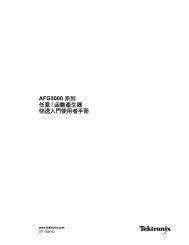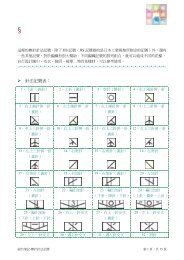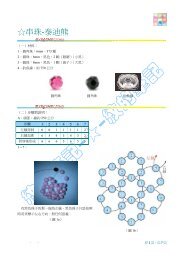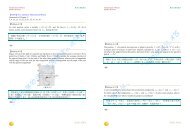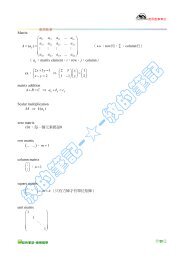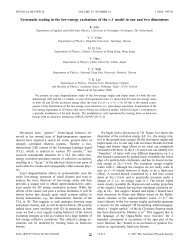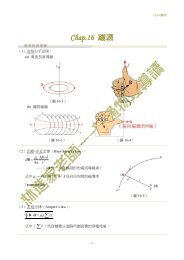Chapter 22 Materials Selection and Design Considerations
Chapter 22 Materials Selection and Design Considerations
Chapter 22 Materials Selection and Design Considerations
Create successful ePaper yourself
Turn your PDF publications into a flip-book with our unique Google optimized e-Paper software.
<strong>22</strong>.3 Other Property <strong>Considerations</strong> <strong>and</strong> the Final Decision • W93<br />
2/3 — 2/3<br />
Table <strong>22</strong>.2 Tabulation of the �/�f Ratio, Relative Cost (c ), <strong>and</strong> the Product of �/�f <strong>and</strong><br />
— a<br />
c for Five Engineering <strong>Materials</strong><br />
2�3<br />
���f Material [10 �2 {Mg�(MPa) 2�3 m 3 }] ($�$) [10 �2 ($�$){Mg�(MPa) 2�3 m 3 }]<br />
Table <strong>22</strong>.2. In the first column is tabulated The next column lists the approximate<br />
relative cost, denoted as this parameter is simply the per-unit mass<br />
cost of material divided by the per-unit mass cost for low-carbon steel, one of the<br />
common engineering materials. The underlying rationale for using is that while<br />
the price of a specific material will vary over time, the price ratio between that<br />
material <strong>and</strong> another will, most likely, change more slowly.<br />
Finally, the right-h<strong>and</strong> column of Table <strong>22</strong>.2 shows the product of <strong>and</strong><br />
This product provides a comparison of these several materials on the basis of the cost<br />
of materials for a cylindrical shaft that would not fracture in response to the twisting<br />
moment We use this product inasmuch as r�t is proportional to the mass of<br />
material required (Equation <strong>22</strong>.8) <strong>and</strong> c is the relative cost on a per-unit mass basis.<br />
Now the most economical is the 4340 steel, followed by the glass fiber-reinforced<br />
composite, 2024-T6 aluminum, the carbon fiber-reinforced composite, <strong>and</strong> the titanium<br />
alloy. Thus, when the issue of economics is considered, there is a significant<br />
alteration within the ranking scheme. For example, inasmuch as the carbon fiberreinforced<br />
composite is relatively expensive, it is significantly less desirable; in other<br />
words, the higher cost of this material may not outweigh the enhanced strength it<br />
provides.<br />
2�3<br />
r�t c.<br />
Mt. f<br />
2�3<br />
r�t<br />
c;<br />
c<br />
f<br />
2�3<br />
f .<br />
<strong>22</strong>.3 OTHER PROPERTY CONSIDERATIONS AND<br />
THE FINAL DECISION<br />
To this point in our materials selection process we have considered only the strength<br />
of materials. Other properties relative to the performance of the cylindrical shaft<br />
may be important—for example, stiffness, <strong>and</strong>, if the shaft rotates, fatigue behavior<br />
(Sections 8.7 <strong>and</strong> 8.8). Furthermore, fabrication costs should also be considered; in<br />
our analysis they have been neglected.<br />
Relative to stiffness, a stiffness-to-mass performance analysis similar to that<br />
above could be conducted. For this case, the stiffness performance index is<br />
P s � 1G<br />
r<br />
(<strong>22</strong>.11)<br />
where G is the shear modulus. The appropriate materials selection chart (log G<br />
versus log r)<br />
would be used in the preliminary selection process. Subsequently,<br />
performance index <strong>and</strong> per-unit-mass cost data would be collected on specific<br />
–<br />
c<br />
– 2�3<br />
c(���f<br />
)<br />
4340 Steel (oil-quenched<br />
<strong>and</strong> tempered)<br />
9.2 5 46<br />
Glass fiber-reinforced composite<br />
(0.65 fiber fraction)<br />
1.9 40 76<br />
b<br />
Aluminum alloy (2024-T6) 6.2 15 93<br />
Carbon fiber-reinforced composite<br />
(0.65 fiber fraction)<br />
1.4 80 112<br />
b<br />
Titanium alloy (Ti-6Al-4V) 6.8 110 748<br />
a<br />
The relative cost is the ratio of the price per-unit mass of the material <strong>and</strong> low-carbon steel.<br />
b<br />
The fibers in these composites are continuous, aligned, <strong>and</strong> wound in a helical fashion at a 45�<br />
angle relative to<br />
the shaft axis.<br />
P s



